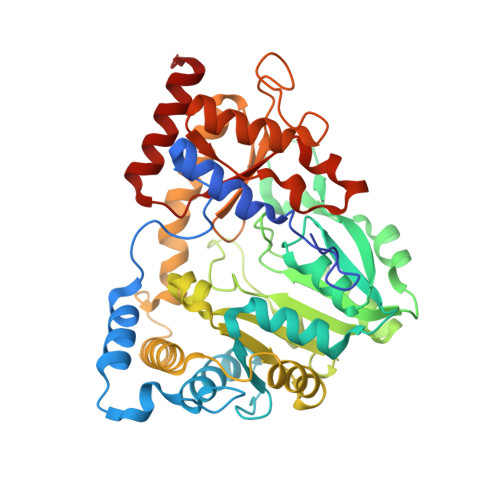Crystal structures of Aedes aegypti kynurenine aminotransferase.
Han, Q., Gao, Y.G., Robinson, H., Ding, H., Wilson, S., Li, J.(2005) FEBS J 272: 2198-2206
- PubMed: 15853804
- DOI: https://doi.org/10.1111/j.1742-4658.2005.04643.x
- Primary Citation of Related Structures:
1YIY, 1YIZ - PubMed Abstract:
Aedes aegypti kynurenine aminotransferase (AeKAT) catalyzes the irreversible transamination of kynurenine to kynurenic acid, the natural antagonist of NMDA and 7-nicotinic acetycholine receptors. Here, we report the crystal structure of AeKAT in its PMP and PLP forms at 1.90 and 1.55 A, respectively. The structure was solved by a combination of single-wavelength anomalous dispersion and molecular replacement approaches. The initial search model in the molecular replacement method was built with the result of single-wavelength anomalous dispersion data from the Br-AeKAT crystal in combination with homology modeling. The solved structure shows that the enzyme is a homodimer, and that the two subunits are stabilized by a number of hydrogen bonds, salts bridges, and hydrophobic interactions. Each subunit is divided into an N-terminal arm and small and large domains. Based on its folding, the enzyme belongs to the prototypical fold type, aminotransferase subgroup I. The three-dimensional structure shows a strictly conserved 'PLP-phosphate binding cup' featuring PLP-dependent enzymes. The interaction between Cys284 (A) and Cys284 (B) is unique in AeKAT, which might explain the cysteine effect of AeKAT activity. Further mutation experiments of this residue are needed to eventually understand the mechanism of the enzyme modulation by cysteine.
Organizational Affiliation:
Department of Pathobiology, University of Illinois, Urbana, IL 61802, USA.
















